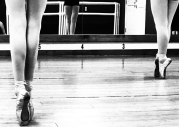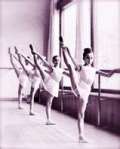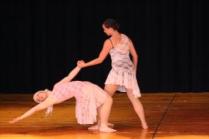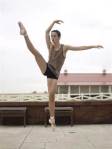 If one is recognized by one’s clothes then a dancer who looks like one goes part of the way in convincing people that they are a dancer. If apparel proclaims the person, a change of apparel proclaims a different person. The dancer’s attitude in class will be one of elegance and confidence. Proper dance clothes will also teach students discipline, helping with overall focus and energy. By “dressing the part,” dancers feel like dancers.
If one is recognized by one’s clothes then a dancer who looks like one goes part of the way in convincing people that they are a dancer. If apparel proclaims the person, a change of apparel proclaims a different person. The dancer’s attitude in class will be one of elegance and confidence. Proper dance clothes will also teach students discipline, helping with overall focus and energy. By “dressing the part,” dancers feel like dancers.
In a traditional ballet classroom, black and only black leotards are the norm. Pink tights along with a skirt, totally completes the dress. Pink ballet shoes that fit properly are essential.
Having a traditional ballet dress code is not only to look the part, but dressing in a black leotard and pink tights ensures that the teacher will be able to see a dancer’s alignment and positioning. The teacher needs to be able to see a dancer’s mistakes. Excessive warm ups and sweatshirts can mask bad habits, making corrections impossible.
The new dance season is upon us with a freshness and excitement of the next level of dance classes coming up. The topic of dancewear is so important to unity in class, but some dancers don’t realize this important part of the dancer’s appearance.
Some schools are lacked in the appearance of their dancers during class time. Allowing for different colored leotards and tights, tee shirts worn over leotards, stylish bras being visible and the like. Some schools say, that it allows for the dancers to be “an individual”. Yes, each dancer is an individual to their teachers, but need to dance as one.
Individual dancewear choices distracts from learning procedure. It distracts attention from unity in the mirror. Individuality has nothing to do with learning to dance. Unity does.
When performing in an ensemble on the stage, aren’t the dancers exactly clothed alike? Would a dancer even allow a portion of an undergarment to be seen from the audience? Why should it be different protocal in class? Professionalism is the key word here. The local dance school should always follow professionalism in all areas in order to teach their dancers that important quality.
Keeping in mind that uniform is a form of discipline, which is also the case of dance, especially ballet. If one is recognized by one’s clothes then a dancer who looks like one goes part of the way in convincing people that they are a dancer. If apparel proclaims the person, a change of apparel proclaims a different person. What better idea than to change into ballet clothes and feel like a dancer? The dancer’s attitude in class will be one of elegance and confidence. Proper dance clothes will also teach students discipline, helping with overall focus and energy. By “dressing the part,” dancers feel like dancers.
In a traditional ballet class room, black and only black leotards are the norm. Pink tights sometimes along with a skirt totally completes the dress. Pink ballet shoes that fit properly are essential.
Look like a dancer …..feel like a dancer!








